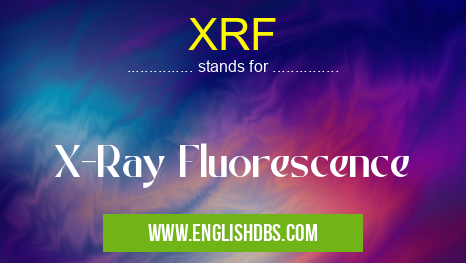What does XRF mean in ACADEMIC & SCIENCE
Introduction:

XRF meaning in Academic & Science in Academic & Science
XRF mostly used in an acronym Academic & Science in Category Academic & Science that means X-Ray Fluorescence
Shorthand: XRF,
Full Form: X-Ray Fluorescence
For more information of "X-Ray Fluorescence", see the section below.
XRF: Meaning and Applications in Science
XRF stands for X-Ray Fluorescence, a non-destructive analytical technique used to determine the elemental composition of materials. It involves irradiating a sample with X-rays, causing the emission of secondary X-rays characteristic of the elements present.
Principle of XRF:
XRF utilizes the principle of atomic fluorescence. When an X-ray photon interacts with an atom, it can eject an electron from an inner shell. The resulting vacancy is filled by an electron from an outer shell, releasing energy in the form of an X-ray photon with a wavelength specific to the element involved.
Instrumentation:
XRF instruments typically consist of:
- X-ray source: Emits high-energy X-rays to excite the sample.
- Sample holder: Supports the sample during irradiation.
- Detector: Measures the intensity and wavelength of the emitted X-rays.
- Computer: Analyzes the X-ray data to identify and quantify elements.
Applications of XRF:
XRF is widely used in various scientific fields:
- Environmental Science: Analyzing soil, water, and air samples for pollutants.
- Geology: Identifying minerals and determining elemental composition of rocks.
- Archaeology: Studying ancient artifacts and determining their elemental makeup.
- Materials Science: Characterizing materials for quality control and research.
- Forensic Science: Analyzing evidence for elemental composition.
Advantages of XRF:
- Non-destructive: Does not alter the sample.
- Multi-elemental: Can detect a wide range of elements simultaneously.
- Rapid: Results can be obtained in minutes.
- Versatile: Applicable to various types of samples, including solids, liquids, and powders.
Essential Questions and Answers on X-Ray Fluorescence in "SCIENCE»SCIENCE"
What is X-Ray Fluorescence (XRF)?
XRF is an analytical technique that uses X-rays to determine the elemental composition of a material. It is a non-destructive and versatile technique that can be used to analyze a wide variety of materials, including solids, liquids, and gases.
How does XRF work?
When an X-ray beam strikes a material, the atoms in the material absorb the energy from the X-rays and emit their own characteristic X-rays. The energy of these emitted X-rays is specific to the element, so by analyzing the energy of the emitted X-rays, it is possible to determine the elemental composition of the material.
What are the advantages of using XRF?
XRF has several advantages over other analytical techniques, including:
- Non-destructive: XRF does not require the destruction of the sample being analyzed.
- Versatile: XRF can be used to analyze a wide variety of materials, including solids, liquids, and gases.
- Rapid: XRF is a rapid analytical technique that can provide results in minutes.
- Sensitive: XRF is a sensitive analytical technique that can detect trace levels of elements.
What are the applications of XRF?
XRF is used in a wide variety of applications, including:
- Materials characterization: XRF can be used to determine the elemental composition of materials, which can be useful for identifying materials, determining their purity, and studying their properties.
- Environmental analysis: XRF can be used to analyze the elemental composition of environmental samples, such as soil, water, and air. This information can be used to assess the levels of pollutants in the environment and to monitor the effectiveness of pollution control measures.
- Forensic analysis: XRF can be used to analyze the elemental composition of forensic samples, such as glass, paint, and gunshot residue. This information can be used to link suspects to crime scenes and to identify the type of weapon used in a crime.
Final Words: XRF is a valuable analytical technique that provides rapid and accurate elemental analysis. Its non-destructive nature and versatility make it a preferred choice for various scientific and industrial applications. XRF continues to play a crucial role in advancing our understanding of materials and the environment.
